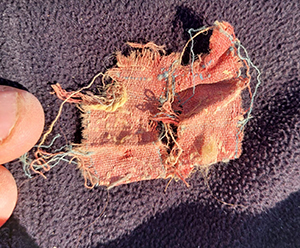
HAIFA, Israel (Press Release) — Have researchers discovered the Israeli “Silk Road”? A joint excavation is underway at the Nahal Omer site in the Arava, led by Prof. Guy Bar-Oz from University of Haifa, Dr. Roi Galili from Ben-Gurion University, Dr. Orit Shamir from the Israel Antiquities Authority, Dr. Berit Hildebrandt of Göttingen University in Germany, and Nofar Shamir from the University of Haifa. Working in the Arava, the southeastern part of Israel paralleling the Jordanian border, the researchers have uncovered a large quantity of findings imported from the East and dated to the Early Islamic period, some 1,300 years ago. The findings include cotton and silk fabrics that probably originated from India and China. “Our findings seem to provide the first evidence that there was also an ‘Israeli Silk Road’ used by merchants along the international trading routes. This route branched off from the traditional Silk Route that passed to the north of Israel, crossing the Arava and connecting to the main historical trade routes that crossed the country, as well as to the main ports of Gaza and Ashkelon that served a major gateways to the Mediterranean world,” explains Prof. Guy Bar-Oz of the School of Archeology and Maritime Cultures at the University of Haifa, who is leading the excavation.
The Silk Road was the main trading route that was used for movement of exotic goods from China through India, Egypt, and the Middle East to Europe. The main strand of the route ended in Constantinople, the capital of the Byzantine Empire (modern-day Istanbul). “The patterns of produce movement and the range over which commerce was conducted highlight the processes of globalization that influenced the Middle East toward the end of the first millennium,” explain Prof. Bar-Oz and Dr. Galili. “Until now, academic discussion of the format of ancient trade was based mainly on historical sources. Archeological remains that allow us to touch the material itself were rare.” In this study, the researchers are exploring the changes that took place over the course of time by means of an analysis of accumulations of garbage at sites along the trading routes. Their goal is to learn about the everyday lives of the traders who led the ancient convoys and to search for the exotic fabrics they carried on their way. The research included the examination of trash mounds at the Nahal Omer site in the Arava, which dates back to the seventh century CE, the beginning of the Islamic Era in the region.
The researchers were surprised to find a veritable treasure trove including rich findings that provide a detailed insight into the material culture and daily lives of the ancient residents of this desert region: fabrics, items of clothing, a variety of hygienic products (including ear swabs and bandages), leather straps, belts, socks, shoe soles, combs, and so on. The wealth of organic material enabled the researchers to undertake precise dating using carbon 14, and the items were dated to the 7th-8th centuries CE. “The findings include a large proportion of imported items, including fabrics bearing typical decorations of Indian origin and silk items from China. This is the first time that these items dating back to this period have been found in Israel. The variety and richness of the findings shows that luxury goods from the East were in high demand at the time,” adds Dr. Shamir, an expert in fabrics. The researchers believe it is likely that the cotton fabrics came from India and Nubia (modern-day Sudan), the two best-known centers of cotton manufacturing in this period. The silk fabric uncovered provides strong evidence of trade originating in China.
As far as textiles are concerned, Nahal Omer is the most important of all the ancient sites discovered to date in Israel. The findings from the site reflect step progress in technological developments. A large quantity of cotton fabrics was found at the site, some of which bear ikat designs. In the ikat technique, the warp is tied and died before weaving according to a preprepared model. Until now, ikat fabrics have only been found at a small number of sites in the Middle East. In contrast, wall paintings in the Ajanta caves in India dated to the sixth century CE show figures wearing clothes with designs similar to those found at Nahal Omer. The fabrics also include an Iranian twist. The researchers found fabrics at the site made from white cotton and colored wool woven together in a complex process. This material was used to make rugs, which are still manufactured to this day using a similar process in Iran and other parts of Central Asia. The researchers note that the colors of the fabrics have been preserved well and include a wide range of colors and shapes in blue, using indigo, red from Rubia tinctorum, brown, and other shades.
The researchers add that in the Early Islamic era, the historical Spice Route that had been used to carry goods from southern Arabia to the ports on the Mediterranean during the Hellenistic and Roman periods was no longer active. Accordingly, they suggest that the current findings mark a pronounced globalizing moment in the Negev history, when the Incense Road merged with the Silk Road and a package of new type of goods spread from East and South Asia into Mediterranean lands. “The findings from the excavation reflect unique contacts on a global level with sources of fabric manufacturing in the Far East. They provide us with new ways to track political, technological and social interactions that have been constantly reshaped by trade networks. We can now explore in more details long-distance movement of goods, geographic diffusion of people and ideas and connections along the roads and production centers. All these were, until now, historically and archaeologically invisible or incompletely recorded. Our new findings is an important step in that direction,” Prof. Bar-Oz concludes.
*
Preceding provided by the University of Haifa.